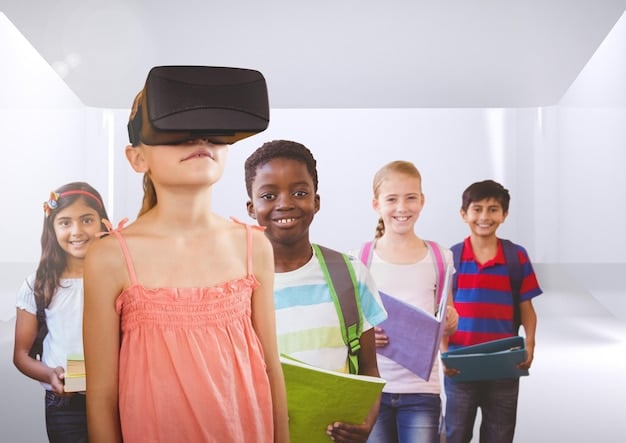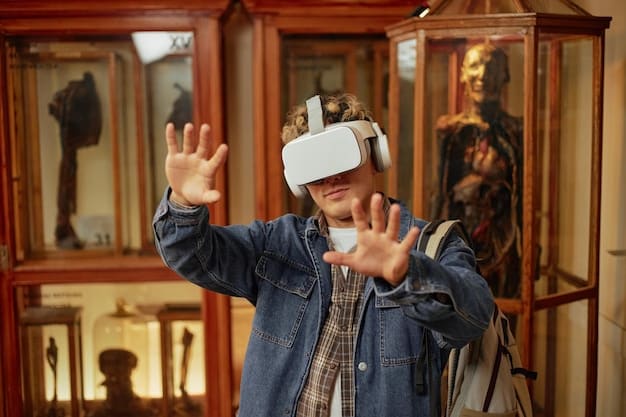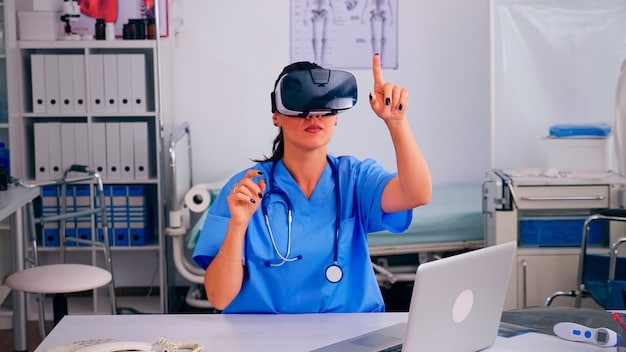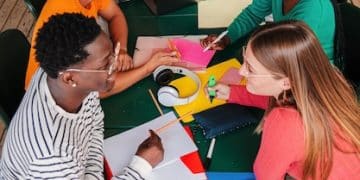Integrate VR into US Schools: Boost Student Engagement

Anúncios
Integrating virtual reality (VR) into US schools enhances student engagement by providing immersive, interactive learning experiences that cater to diverse learning styles, making education more captivating and effective.
How Can US Schools Integrate Virtual Reality into the Classroom to Improve Student Engagement? It’s a question gaining traction as educators seek innovative methods to captivate students and enhance learning outcomes. Virtual Reality (VR) offers an immersive, interactive educational experience that can transform traditional teaching methodologies.
Anúncios
Unlocking the Potential of VR in Education
Virtual Reality (VR) is rapidly evolving, presenting new opportunities for enhancing education. Its ability to create immersive and interactive learning environments makes it a powerful tool for educators looking to improve student engagement and cater to diverse learning styles.
By integrating VR into the classroom, educators can bring abstract concepts to life, allowing students to explore historical events, scientific phenomena, and complex systems in a way that traditional methods cannot.
Anúncios
The Benefits of VR in Education
VR offers a range of benefits that can significantly enhance the learning experience. Here are some key advantages:
- Increased Engagement: VR captures students’ attention and keeps them focused on the lesson.
- Enhanced Understanding: Immersive experiences make abstract concepts more concrete and understandable.
- Personalized Learning: VR can adapt to individual learning styles and paces.
- Global Exploration: Students can virtually travel to different locations and experience diverse cultures.
Overcoming Challenges in VR Implementation
While VR offers numerous benefits, there are also challenges to consider. Addressing these challenges is crucial for successful integration.
- Cost: VR equipment can be expensive, requiring careful budgeting and resource allocation.
- Technical Support: Schools need adequate technical support to maintain and troubleshoot VR systems.
- Teacher Training: Educators need training to effectively integrate VR into their lesson plans.
- Content Development: High-quality, educational VR content needs to be developed and curated.

Successfully integrating VR into education hinges on strategic planning and investment in both hardware and teacher training. By addressing these challenges head-on, schools can maximize the benefits of VR and create transformative learning experiences for their students.
Curriculum Integration Strategies for VR
Integrating VR effectively requires careful planning and curriculum alignment. It’s not just about using the technology; it’s about using it in a way that enhances learning outcomes.
Here are some strategies for seamlessly integrating VR into various subjects, ensuring it complements and reinforces existing learning objectives.
Science Education
VR can revolutionize science education by allowing students to explore complex topics in an immersive way.
- Virtual Labs: Conduct experiments in a safe and controlled virtual environment.
- Anatomical Exploration: Explore the human body in detailed, interactive 3D.
- Environmental Studies: Study ecosystems and natural phenomena firsthand.
History and Social Studies
VR brings historical events and cultures to life, making history more engaging and memorable.
- Historical Recreations: Step back in time and experience historical events firsthand.
- Cultural Immersion: Explore different cultures and societies through virtual tours.
- Geographical Exploration: Visit landmarks and geographical locations around the world.
Effective integration of VR in education means ensuring that the technology serves the curriculum, not the other way around. By aligning VR experiences with specific learning objectives, teachers can create engaging and effective educational opportunities.
VR Applications Across Different Grade Levels
The applications of VR in education vary depending on the grade level. What works for elementary school students may not be suitable for high school students, and vice versa.
Here are some examples of how VR can be used effectively across different grade levels to enhance learning experiences and cater to the specific needs of students.
Elementary School
At the elementary level, VR can be used to introduce basic concepts in an engaging and interactive way.
- Interactive Storytelling: Bring stories to life with immersive VR experiences.
- Basic Science Concepts: Explore simple scientific concepts like the solar system or the water cycle.
- Virtual Field Trips: Visit zoos, museums, and historical sites without leaving the classroom.
Middle School
In middle school, VR can be used to explore more complex topics and promote critical thinking.
- Historical Simulations: Participate in historical reenactments and simulations.
- Scientific Experiments: Conduct virtual experiments that are too dangerous or costly in real life.
- Cultural Exchanges: Connect with students from other countries through virtual cultural exchanges.
High School
At the high school level, VR can be used to prepare students for college and careers.
- Vocational Training: Simulate real-world work environments and train for specific jobs.
- College Preparation: Take virtual tours of college campuses and learn about different academic programs.
- Advanced Science Studies: Explore complex scientific concepts in detailed, interactive 3D models.

By tailoring VR experiences to the specific needs and interests of students at each grade level, educators can maximize the impact of this technology and create engaging learning opportunities.
Enhancing Accessibility and Inclusion with VR
VR has the potential to enhance accessibility and inclusion in education, providing opportunities for students with disabilities to participate more fully in the learning process.
By creating immersive experiences that can be tailored to individual needs, VR can break down barriers and promote inclusivity in the classroom.
Supporting Students with Visual Impairments
VR can provide visual experiences for students with limited or no vision.
- Audio-Based VR: Use spatial audio to create immersive experiences that don’t rely on sight.
- Haptic Feedback: Incorporate haptic feedback to provide tactile information about the virtual environment.
Supporting Students with Auditory Impairments
VR can provide visual and interactive experiences for students who are deaf or hard of hearing.
- Visual Cues: Use visual cues and subtitles to convey information.
- Sign Language Avatars: Incorporate avatars that use sign language to communicate.
Supporting Students with Learning Disabilities
VR can provide personalized learning experiences that cater to different learning styles.
- Multi-Sensory Experiences: Engage multiple senses to enhance learning and retention.
- Adaptive Learning: Adjust the pace and difficulty of the VR experience to meet individual needs.
By creating inclusive VR experiences, educators can ensure that all students have the opportunity to participate and succeed in the classroom. This not only promotes equity but also enriches the learning environment for everyone.
Measuring the Impact of VR on Student Performance
Measuring the impact of VR on student performance is crucial for justifying its use and ensuring that it is effectively improving learning outcomes. Schools need to collect data and analyze the results to determine whether VR is making a difference.
Here are some methods for measuring the impact of VR on student performance, as well as considerations for evaluating the effectiveness of VR programs.
Quantitative Measures
Quantitative measures provide objective data on student performance that can be easily analyzed.
- Test Scores: Compare test scores of students who use VR with those who don’t.
- Grades: Track changes in student grades after implementing VR programs.
- Attendance Rates: Monitor attendance rates to see if VR is improving student engagement.
Qualitative Measures
Qualitative measures provide insights into student attitudes and perceptions.
- Surveys: Conduct surveys to gather feedback from students and teachers.
- Interviews: Conduct interviews to gain a deeper understanding of student experiences.
- Observations: Observe students in the classroom to see how they interact with VR technology.
Regular assessment and feedback are essential for optimizing VR programs and ensuring they are meeting the needs of students. By continuously evaluating the impact of VR, schools can make informed decisions about how to use this technology most effectively.
The Future of VR in US Schools
The future of VR in US schools is bright, with ongoing advancements in technology and increasing recognition of its potential to transform education. As VR becomes more affordable and accessible, more schools are likely to adopt it.
Looking ahead, here are some potential developments and trends that could shape the future of VR in education, leading to more engaging and effective learning experiences.
Advancements in VR Technology
Ongoing advancements in VR technology will make it more immersive, affordable, and accessible.
- Improved Hardware: Expect to see lighter, more comfortable VR headsets with higher resolution displays.
- Wireless VR: Wireless VR systems will eliminate the need for cables, providing greater freedom of movement.
- Enhanced Interactivity: New input methods, such as hand tracking and eye tracking, will make VR more interactive.
Expanding Content Libraries
The availability of high-quality educational VR content will continue to grow.
- Curriculum-Aligned Content: More VR experiences will be designed to align with specific learning objectives.
- Interactive Simulations: Expect to see more interactive simulations that allow students to explore complex systems.
- Collaborative Experiences: VR will enable students to collaborate and learn together in virtual environments.
The integration of VR into US schools is not just a passing trend; it’s a fundamental shift in how education is delivered. By embracing this technology and adapting to the changing landscape, educators can create more engaging and effective learning experiences for their students.
| Key Point | Brief Description |
|---|---|
| 🚀 Increased Engagement | VR captures students’ attention through immersive experiences. |
| 🌍 Global Exploration | VR allows virtual travel, enhancing cultural understanding. |
| 👩🏫 Teacher Training | Effective VR integration requires trained educators. |
| 💡 Curriculum Alignment | VR should complement and reinforce learning objectives. |
FAQ
▼
VR enhances student engagement by offering immersive, interactive experiences that capture their attention and make learning more enjoyable and effective, catering to different learning styles.
▼
Various subjects can benefit from VR, including science, history, and social studies, as it allows students to explore complex topics and historical events in an immersive manner.
▼
Challenges include the cost of VR equipment, the need for technical support and teacher training, and ensuring that the content aligns with the curriculum and is engaging.
▼
VR offers personalized experiences for students with visual or auditory impairments, with adjustable learning styles and adaptive approaches, promoting accessibility and inclusive learning in the classroom.
▼
Schools can measure the impact through test scores, grades, attendance rates, surveys, interviews, and classroom observations, providing both quantitative and qualitative data for evaluation and improvement.
Conclusion
Integrating virtual reality into US schools offers a transformative approach to education, fostering student engagement and enhancing learning outcomes. As technology evolves, VR’s potential to bridge the gap between traditional education and immersive experiences becomes increasingly evident, paving the way for a future where students are not just learning but actively participating in their education.





